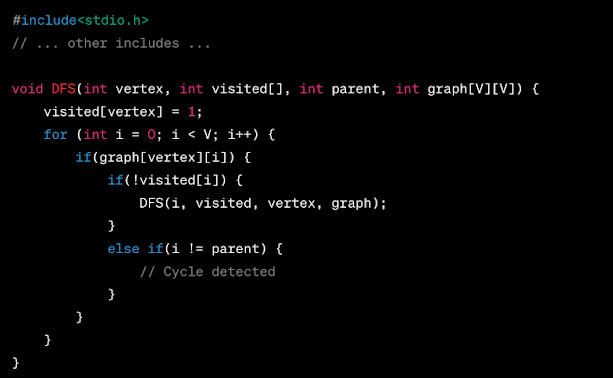Ah, the fascinating world of graphs! One cannot traverse the universe of computer science without bumping into this essential structure. Today, we dive deep into a specific challenge that often tickles the brain cells of budding programmers – detecting cycles within graphs using the C programming language. Why is this vital? Well, cycles can sometimes represent unwanted scenarios in various applications. Think of it as finding an unintended loop in a one-way street network. Not cool, right?
Understanding Graphs
Before we race into cycle detection, it’s paramount to understand graphs’ foundation.
- Vertices and Edges: Think of vertices as cities and edges as highways. A graph is essentially a collection of cities interconnected by highways;
- Directed vs. Undirected Graphs: In a directed graph, you can only travel one way on a highway. In contrast, an undirected graph allows travel in both directions.
Cycle in Graphs – What’s the Fuss?
Detecting a cycle is like identifying a route that takes you back to your starting city without retracing any part of your journey. Here’s why it matters:
Resource Deadlocks
Imagine a scenario where tasks depend on each other to complete. If they wait indefinitely for each other, nothing gets done!
Network Protocols
Ensuring data packets don’t roam indefinitely within a network loop is crucial.
Methods to Detect Cycle
Let’s dissect the popular methods:
Depth First Search (DFS)
Like exploring a maze, you keep moving as far forward as you can. If you encounter a previously visited node, bingo! You’ve found a cycle.
Union-Find Algorithm
Think of this as a club membership system. Every time you want to connect two cities (nodes), you check if they belong to the same club. If they do, a cycle is imminent.
Implementing DFS in C
Here’s a brief code snippet to visualize cycle detection using DFS:

Understanding the Code:
- Begin DFS from a non-visited vertex;
- Traverse its adjacent vertices. If any adjacent vertex is visited and isn’t the parent of the current vertex, a cycle is detected.
Union-Find Algorithm in Action
Conceptually, this method involves maintaining disjoint sets of vertices and checking for cycles as we add edges.
Pseudo Implementation:
- Assign a unique set to every vertex;
- For each edge (U, V), find the sets S_U and S_V of U and V respectively;
- If S_U is equal to S_V, there’s a cycle;
- Otherwise, merge S_U and S_V.
Comparing DFS vs. Union-Find
| Criterion | DFS | Union-Find |
|---|---|---|
| Time Complexity | O(V+E) | Almost O(V) |
| Space Complexity | O(V) | O(V) |
| Best Used For | Sparse Graphs | Dense Graphs |
| Implementation Complexity | Moderate | More Involved |
Practical Applications
- Networking: Avoiding routing loops;
- Database Transactions: Avoiding deadlocks;
- 3D Modeling: Identifying circular references.
Tips and Tricks
- Always initialize your visited array or set;
- For directed graphs, maintain an additional array to track vertices currently in the recursion stack to detect cycles;
- Visualize the graph. Sometimes, a pen and paper can be more powerful than the most advanced computer.
Reading a File into a String in C++
Taking a short detour from graphs, let’s discuss a common operation many C++ programmers find themselves needing: reading a file into a string. In C++, this is a straightforward operation, thanks to the Standard Library.
Steps:
1. Include Necessary Headers: First, make sure to include the necessary headers.

2. Open File with ifstream: The ifstream class from the <fstream> header is used to open files for reading.

3. Read File into String: Use the std::getline() function combined with the std::string object to read the file content.

4. Close the File: Always a good practice to close the file after reading.

Quick Tip: Ensure proper error handling. Always check if the file is opened successfully before proceeding to read.
Conclusion
Unearthing cycles in graphs is a potent skill in a programmer’s toolkit, especially when maneuvering within the lanes of C. By mastering both DFS and Union-Find techniques, you’re well-equipped to handle challenges that demand cycle detection in real-world scenarios.
FAQs
Identifying cycles can help prevent system deadlocks, network routing loops, and circular references in software design.
Absolutely! While our focus was C, the core logic remains applicable across various programming languages.
C offers a balance between low-level memory management and high-level algorithm implementation, making it ideal for graph-based challenges.
The basic principle remains consistent, but the implementation might require tweaks, especially with back edges in directed graphs.
It depends on the use case. DFS is generally simpler and apt for sparse graphs, while Union-Find is suitable for dense graphs.